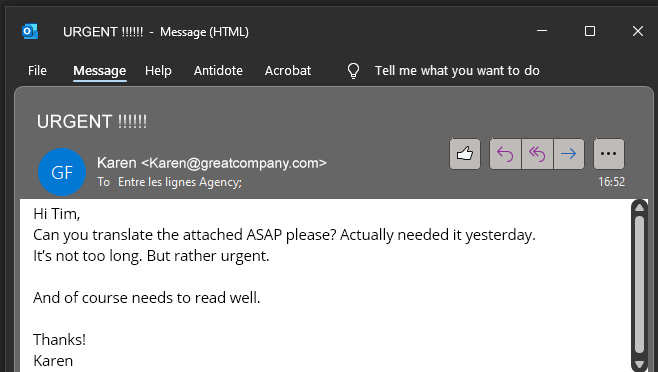If you are reading this article, it is highly likely that you have regular dealings with translators or translation agencies. We want to offer you the opportunity to provide them with the most efficient briefing. This means keeping email traffic to a minimum and making sure that everything you agree on is completely clear so that you get the result you want and deserve.
Do you want to download the checklist without reading the article?
Just click here 👉 for a free template
📩 Incoming email

Our reaction:

Phew – rest assured, this email is totally fictitious and Karen doesn’t exist. Although I’ve called her Karen because she is a real Karen – if you get my meaning.
The email does however present a common pitfall that needs a solution: How do you ensure that your translator grasps what you need straight away and that your email doesn’t go straight into their spam folder?
Here we go.
1. Subject field: project name, language combination(s), volume and deadline
Hello Karen – first thing get rid of those caps and exclamation marks from your subject field. Translators are completely indifferent to them. Beats me, but they are.
No, seriously. Make sure that your subject field covers the full scope of your request. So that your intention is completely clear.
If, for instance, you want to translate the Rob Christmas catalogue from French into Dutch, your subject field should be:
Translation Christmas Catalogue Rob FR-NL, 7500 words, 31.12.2021
This immediately gives your translation partner a good idea of what your request entails and if it can be reasonably achieved.
2. Language combinations and language variants
Come on, Karen. You didn’t even mention which target language your text was to be translated into. Get a grip!
I get it. Inside your head, all is as clear as daylight. But that is not the case for your translation partner. Let’s give you an example, here in our agency we translate into 36 different languages. So that gives us 35 opportunities to get it wrong.
Once you have mentioned the target language the next important aspect is the language variant. By this I mean the specific market that your communication is aimed at. By way of example, if you want a translation into Dutch you should mention if it is aimed at Belgium, the Netherlands, or both markets. The Dutch that is used in the Netherlands and Belgium may well be identical on paper, but can be very different when it comes to tone of voice and idioms.
3. Translators calculate in numbers of words
This applies in particular to high-volume projects such as brochures, catalogues, blogs, etc. You can check the number of words in Word in the bar at the bottom of the page. If you are working in a different format just copy the content into a Word document where you can check the wordcount.
Translators are usually able to process about 2500 words per day. Some translators work more speedily than others, but this gives you a good ballpark figure. By providing the wordcount your translation partner can immediately see if they can fit your project into their schedule.
Worth noting: As an agency, we have the advantage of working with large teams of translators which enables us to translate a lot more words per day if needed. However, in these instances extra time must be set aside to carry out in-depth revisions to ensure that the tone and terminology are consistent throughout.
Worth noting also: All our translations are automatically scanned by the eagle eyes of our revisers. The average volume of revised words per day is approximately 8,000. They’re on fire!
4. An editable attachment speaks volumes.

Really… Karen, what were you thinking?
OK, now we are being really tough. And… I have to own up. Let him who is without the sin of forgetting an attachment cast the first stone.
But actually the point we are focussing on is the word « editable ». A file in which you can edit text without too much fiddling around. Word or Google Doc are the most obvious examples. Excel or PowerPoint are also fine.
Non-editable files such as PDFs or images with text have to be converted before we can work on them. This is not insurmountable, but takes some extra time and input.
Worth noting: If your project involves translating a graphic brochure and you don’t want to copy-paste everything like crazy, you can also send us the IDML file. We will then return it to you properly translated. Your graphic designer will thank you.
And yet another point worth noting: thanks to our DTP team, we can convert non-editable files into an editable format so that the translation you receive is in exactly the same layout as the original text.
